The Inca Trial
I can safely recommend the train from Puno to Cuzco, but make sure you
go on the day one, as the only reason to travel this distance by train
is the stunning views the trip offers. There are night trains as well,
but they are only useful if you prefer sleeping while having your body
tossed around wildly, and while it'd take you only half a minute of
shaking inside the compartment to create a high-quality milkshake,
it'll take the train 9 hours to bring you to your destination. So just
don't. But the day train is a good trip, you get 9 full hours or more
for the mere price of US$19 and upwards, depending on what class and
meal program you choose.
Before the train guards would let me enter the train, I had to check
my luggage in with the train company, as if it was an airline or
something. It was hard to go against the principle of never leaving my
luggage out of sight while in Peru, but since all the other passengers
also had to do this, I gave in. At the check-in counter my backpack
became attraction number one of the day among a group of Italians, who
took pictures of me and my backpack and asked me all kinds of strange
questions about the patches I have pretty much covered the backpack
with throughout my travels. The patches is a large part of the reason
I'm so fond of my backpack, and when I parted with it, we took a
thorough farewell, and I sighed and really hoped we would meet again
on the other side.
The ride itself offers very scenic views, but there is a lot to see
and experience inside the train as well. The compartment I travelled
in was from 1917, which may have made it one of the oldest ones in
normal use anywhere. It was also quite nice-looking, but certainly
not too comfortable, probably at least partly due to the bumpy
tracks. Various signs here and there added to the mood among the
passengers, who were all tourists since most Peruvians choose the
much cheaper and quicker buses instead. "IT IS NOT PERMITTED TO JUMP
FROM WAGON TO ANOTHER WAGON", read one. Another one said "No animal
because of its noise, bite or other characteristica that can bother
passenger are permitted". There was also an ad for eating in Cuzco:
"Have a Machu Pizza in the Smack Bar". Things like that make me smile.
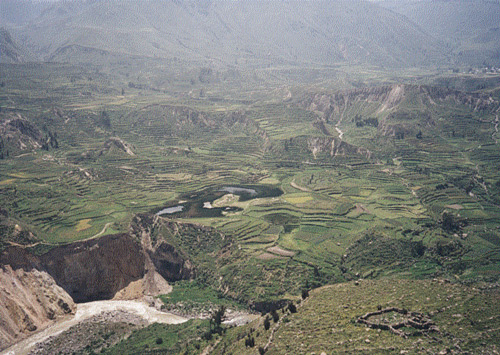 I was seated between some Frenchmen and some Japanese, so I didn't
have to say anything for the whole duration of the trip, except for an
"Au revoir" and a "Sayonara" when we got off. That was okay with me, I
had brought a book and besides there was a 9 hour long postcard
outside the windows. First there was the amazingly blue Lake Titicaca
to enjoy, all still for the lack of wind on this spectacular
day. The train kept rolling, and was chased by rabid dogs past and
through lots of villages with beautiful churches surrounded by
shantytowns, where the train used to make stops in before the railway
company was privatized. In between there were farmland and mountains,
with lots of sheep and llamas looking at the train as if they've never
seen anything like it before. Sometimes there were shepherds following
the animals, and everywhere there were incredible terraces of maize and
potato fields climbing halfway up to the sky in the Cordillera
Blanca. It's enough to keep you occupied, like the toilet on the train
also was. Someone must have eaten something.
I was seated between some Frenchmen and some Japanese, so I didn't
have to say anything for the whole duration of the trip, except for an
"Au revoir" and a "Sayonara" when we got off. That was okay with me, I
had brought a book and besides there was a 9 hour long postcard
outside the windows. First there was the amazingly blue Lake Titicaca
to enjoy, all still for the lack of wind on this spectacular
day. The train kept rolling, and was chased by rabid dogs past and
through lots of villages with beautiful churches surrounded by
shantytowns, where the train used to make stops in before the railway
company was privatized. In between there were farmland and mountains,
with lots of sheep and llamas looking at the train as if they've never
seen anything like it before. Sometimes there were shepherds following
the animals, and everywhere there were incredible terraces of maize and
potato fields climbing halfway up to the sky in the Cordillera
Blanca. It's enough to keep you occupied, like the toilet on the train
also was. Someone must have eaten something.
The train arrived in Cuzco slightly delayed, the sun had just set and
now it was getting dark. There are no cities in Peru where more
tourists are being mugged than in Cuzco (ok, so maybe there are no
cities in Peru that get more tourists than Cuzcu either), so I was
happy to be hunted down by an old women who wanted me to rent a room
at her hostel. She took me there, away from the railway station area,
I had a polite look at the room and declared that I thought less than
4 dollars for a room right in the middle of Cuzco was way too cheap,
and went next door and paid about triple that price for a room
there. My rationale was that I really wanted to be comfortable and
safe in Cuzco, with luxuries such as a lockable door and hot water in
the shower. Besides, if I were to empty my travel budget, I would have
to spend 900 dollars per day from now on until the end. That would
definitely be impossible with a 4 dollar room, now I would have a
slightly larger chance of getting a bit closer to spending what I had
though I would on this trip.
I spent a day getting to know the old Inca capital. On the surface
it is an incredibly nice city, with lots of walls and streets standing
and lying around just like the Incas left them. If you REALLY try, you
will be able to find some places in the stonework where you can
squeeze in a sheet of paper between the stones, but most of the
stonework is as close to perfect as is possible. Huge stones, fitting
into each other with different sides in all kinds of angles. Some
stones have more than 10 "sides", and when you put together a lot of
stones like that, you get a wall that is pretty much
earthquake-proof. The largest stones I saw in Cuzco were something like 8
meters tall, four meters wide and three meters deep, so the Incas must
have been pretty muscular dudes. Even though they are now gone, Cuzco
is full of modern day indians that are quite happy to sell various
Inca stuff that probably was left behind when the Incas left in their
spaceships, at special prices for everyone.
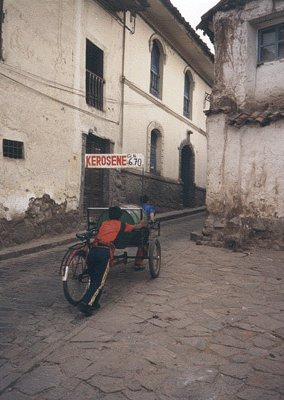 In central Cuzco the Spaniards incorporated the Inca buildings
into their own constructions, for instance "Q'orikancha", the Inca Sun
Temple, was used as the foundation for a large church. If you go a
bit outside the center, however, you can find original Inca stonework
still standing on its own. There is an old road, built by the Incas,
of course, leading from the city center up to Sacsayhuaman (easy to
remember, just think "sexy woman"), where I saw the most impressive
ruins I have seen anywhere. This is where the most massive stonework
can be found, forming something that looks a bit like a fortress with
a jagged outer wall. If you could have a look at the original Inca
Cuzco from above, the borders of the city would take the shape of a
large puma, and these walls form the teeth in the puma's mouth. It's
quite brilliant and must have been an almost inconceivable effort to
build in the first place, so long ago. The view from up there towards
the city is also excellent, it all looks like the Sim Medieval City
computer game will look if it's every made. The atmosphere up there
was a bit damaged by a very noisy rallycross race going on just behind
the ruins, but the stoneworks were enough to soon make me forget about
the cars.
In central Cuzco the Spaniards incorporated the Inca buildings
into their own constructions, for instance "Q'orikancha", the Inca Sun
Temple, was used as the foundation for a large church. If you go a
bit outside the center, however, you can find original Inca stonework
still standing on its own. There is an old road, built by the Incas,
of course, leading from the city center up to Sacsayhuaman (easy to
remember, just think "sexy woman"), where I saw the most impressive
ruins I have seen anywhere. This is where the most massive stonework
can be found, forming something that looks a bit like a fortress with
a jagged outer wall. If you could have a look at the original Inca
Cuzco from above, the borders of the city would take the shape of a
large puma, and these walls form the teeth in the puma's mouth. It's
quite brilliant and must have been an almost inconceivable effort to
build in the first place, so long ago. The view from up there towards
the city is also excellent, it all looks like the Sim Medieval City
computer game will look if it's every made. The atmosphere up there
was a bit damaged by a very noisy rallycross race going on just behind
the ruins, but the stoneworks were enough to soon make me forget about
the cars.
In the afternoon I went sightseeing in the cathedral of Cuzco. Now,
THAT's a cathedral built for showing off. There's a whole wall covered
with gilded saints, Marias and Jesuses with huge silver candlesticks
and silver thrones in front of them, and that's not a small wall I'm
talking about. There are also a lot of enormous paintings, measuring 6
by 7 meters and more, from the renowned Cuzco school. The painters
of this school tried to adjust what they painted to what people around
them could recognize. One funny example of this is the local version
of "The Last Supper", by Marcos Zapata, where the dinner they are
about to fork down, among other things consists of pisco (the local
version of brandy) and roast guinea pig. Because of this, it is not
only Judas that looks rather concerned and worried, but the rest of
the disciples as well, I imagined. But it looks good (the painting,
not the food in particular), and quite sumptuous! They also had
electrical prayer "candles" in there. "Insert 50 centimos here and
pray", they said. And it actually worked, a light came on and
stayed lit for a while after the money was inserted. "Moderno -
Limpio - Economico - Ecologico", said the sign.
When the trekking agencies re-opened after the siesta, I secured
myself a place on a tour to Machu Picchu that would leave in two days
time, led by a guide from SAS. SAS, at US$170, was not
at all the cheapest alternative, but I figured I would feel better
going on a guided trek if I knew there was a decent chance the guides
and porters were paid ok. Normally I would have trekked independently,
but that is not an option on the Inca trail. Later in 2001 they
changed the regulations for the trek, so
check them out if you're thinking of going there. Unless you book
well ahead, there's no guarantee you'll be able to go! I had heard
from other travelers that all the guides in SAS were constantly high
on cocaine, and thought that might make for interesting lectures on
various topics throughout our trek. I REALLY looked forward to this.
I sat down on a bench on Plaza de Armas, boiling with anticipation,
and I think maybe my telekinetic powers were trigged by my
excitedness, resulting in all electricity in Cuzco
disappearing. Suddenly it was pitch black everywhere, except for some
headlight beams from passing cars. As on a cue, the old women selling
Inca items jumped up, walked a bit away from their stands and
squatted, using the official city center square as their toilet. They
weren't noticeably intimidated neither by the lights from the cars nor
by flashing camera, they were too happy about getting this chance to
protest against the city's government and empty their bladders at the
same time, it seemed. Other impressive opportunity seekers were the
little children who walked into the dark but still open shops and came
running out again seconds later, their hands full of chocolate. These
kids sure knew how to split up and disappear really quick. After 20
minutes of intense peeing and shoplifting, the electricity returned to
the square, and so did sanity.
On my waiting day before the trek I got up real early to go on the
local bus to Ollantaytambo. As soon as I learned of this place, it
went straight into my list of places with very strange names I have to
visit, but it turned out there were many other good reasons to go
there. The bus ride was at first nice and quiet, as all the passengers
tried to get the sleep they had deprived themselves of in order to be
able to go on the bus. But suddenly, after half an hour, one of the
locals pulled up his 12 string guitar and started playing his own
version of El Condor Pasa on it. Everybody were annoyed, and when he
had finished he passed his hat around, collecting money for his
efforts. He did not get much, so he played another couple of melodies
and tried again. This time he got a bit more, in return for the
promise he would now stop his playing and singing.
The reason I chose this day to go to the Sacred Valley was that it was
my only possibility to do so, but later I understood that the real
reason was that on Mondays, and this was one of those, there are no
markets anywhere in the valley, and therefore no tourists bother to go
there. That way, if you go to the valley on a Monday, you'll have the
whole place for yourself, largely undisturbed except for by
yourself. When I came to Ollantaytambo (I just love writing that) I
encountered what seemed to be a very lively and traditional little
village. Even the men wore their traditional costumes, which when
there are tourists around is a huge warning sign, meaning "Hey, these
people will do anything in return for your money", but since there
were no tourists around (except for me, and trust me, I didn't look
like I was going to give anyone anything), it was a very good sign of
a real village with real people in it. Anywhere in Peru there seems to
be two kinds of traditional costumes; one is the good old way people
may have dressed for centuries, the other is the team colors of
whatever is the local's favourite soccer team. Here most wore the
first kind, and it actually looked very good.
While the people wearing funny hats and clothing were nice to look at,
the main attraction here was the Inca fortress where the Incas had one
of their few major victories against the Spanish forces led by
Pizarro. It looked much like the agricultural terraces I had seen
elsewhere, but after walking around there alone for a while I could
see how this construction offered a great number of hiding places for
defenders, while leaving the attackers in the open wherever they
went. To move from one terrace to another, the Incas had carved the
large stones so that some of them offered steps to walk on from one
level to another. Quite impressive, it's put together like a game of
3D Tetris, but with stones instead of pixels on a computer screen. The
water supply built in conjunction with this fortress is still working,
with fountains here and there, and there are channels of fresh water
running through modern day Ollantaytambo, taking care of the sewer
there. Very impressive as well, functioning at least a good 500 years
after it was constructed.
Back in Cuzco I happened upon Sophie and Lauren, two British
volunteers from Project
Trust who I first met on the trip to the Colca canyon near
Arequipa. They were heading back to their project in Puerto Maldonado,
but given the choice between a 3 day, 500 kilometer backbreaking trip
on top of a truck or waiting a week for a flight. They knew enough
about the road standards between Cuzco and the jungle city of Puerto
Maldonado in the Amazon Basin to choose to strand themselves in Cuzco
for the week. I, on the other hand, was more than ready to leave, and
hurried back to the hotel to go to sleep so that I could get up early
as soon as possible.
Next morning it was immediately clear that those of us who were going
with SAS were paying a ridiculous price for our Machu Picchu
experience, because when we turned up at the trekking agency at 6 in
the morning, they served us an enormous breakfast. We were introduced
to our guide, Oswill, who to my big disappointment didn't seem to be
the least bit affected by cocaine. Apart from me the group consisted
of 4 Danes, 2 Swedes, 1 Australian, 2 New Zealanders, 2 Argentinians
and 4 Brits, making the group small enough that we had a chance to get
to know each other well fairly quickly. The bus took us to
Kilometer82, where the start of the official 4 day Machu Picchu trek
is, at 2380 meters altitude. Those who wanted porters to carry their
equipment hired them here, and out of principle I of course didn't. I
felt very much up to the challenge, since I felt all right and now had
spent two weeks above 3000 meters altitude without experiencing any
problems. Well, except for a growing addiction to coca leaves, of
course.
Altogether the group had almost as many porters as there were
trekkers, and it was soon obvious that most of what was carried was
food. There were frequent feeding stops, where the porters had run
ahead and put up tents and chairs and prepared the food. We came
along, sat down and ate, and when we finished, the porters pulled down
the tents and cooking utensils and ran ahead again. Repeat. I was
hoping much of the money would go to the guides and porters, but the
food budget was definitely demanding its share of the money we had
paid.
We had not walked far before we saw the first traces of the Incas,
namely the Inca trail itself. The Inca "kingdom" was a large one,
spanning vast land areas, and in order to keep it together it was
necessary to have an efficient infrastructure. So the leaders ordered
building of good trails for their messengers and traders to move on,
and this is one of the best remaining examples of how good those
"roads" really were. That is, it is pretty obvious that the Incas
never discovered, or at least never took advantage of, the wheel. The
trail is basically just an enormous collection of stairs connected
with short, level paths. Despite what most guidebooks say, I think
pretty much anyone can do this trek, even carrying their own gear,
especially if one takes full advantage of the full four days the trek
normally lasts for. You just walk for a while, stop here and there to
enjoy the view, and then walk again. Sooner or later you'll have
covered the full distance, and probably enjoyed the view a lot on your
way there. Just try it for yourself.
Every now and then, often in very steep sections of the trail, you
may be surprised by men jumping out of the bushes, offering to carry
your backpack for money. I suspect these are the men with guns who
until recently jumped out of bushes, asking you less politely to hand
over your money. So now they are really just a nice encounter in the
wild, a sure sign Peru is heading from total chaos to just a little
bit of chaos, and definitely towards a better future. Something you
SHOULD fear, though, is meeting llama parents who are fiercely
guarding their llama families, forcing you to make long detours from
the trail, in order not to be trampled on or to laugh yourself to
death from looking at llamas that try to look scary.
Many places along the trail there are Inca ruins to see. There are
probably many more than the ones we could see, as the vegetation here
is very lush and fast-growing, hiding many treasures from our
eyes. Still, what I looked at most was the trail itself. I think maybe
the Incas had incredibly long legs. That's at least what the height of
the steps indicates. Or maybe we've only discovered the trail the
Incas built to trick the Spaniards into using, while they themselves
used some Inca Superhighway elsewhere. I have to say the dwarves in
Himalaya does a better job at building walkable paths in the
mountains. Or maybe the difference between the Andes and the Nepalese
Himalaya is just 500 years of maintenance. It's hard to tell. The
mountains here, however, look more nice and green than in the
Himalayas. While the Himalayas are just enormous heaps of gravel, here
there's a snug, lush carpet of green leading almost all the way up to
where the snow begins. This is thanks to the continuos supply of
moisture coming from rain and fog drifting up from the high jungle, an
extreme finger leading out of the Amazonas just below.
The evenings on the trek were spent reading and sleeping. On the first
evening we tried to sit down in the dining tent to play card games
after dinner. After five minutes the tent opening was full of porters
with big eyes, who silently wondered when they could go to
bed. Apparently porters sleep on dining tent floors. So we called it a
day and retired to our smaller tents where the only things to do
was to read, to sleep, to count the bumps in the uneven tent floor and
to feel the fresh air at 3200 meters, at the Tres Piedes camp.
After a long, ten hour sleep we woke up to sunrise and a huge
breakfast with porridge, toast and pancakes, before starting to walk
at 7:30. An even climb led up to Warmiwanusca, "Dead Woman's Pass",
at 4200 meters the first of the three passes on the Inca Trail, where
I paused at 10. From there the path went downwards almost back to the
level we started in the morning, where the group arrived between 11
and 12, each walking at his or her own pace. There was a fairly decent
toilet available in a small cottage here, so everybody agreed that
this, and the lunch, had been worth the efforts it had taken to
get here. Just above the campsite there's a post office. An Inca one,
even. Or at least that's what they think it is. It is a circular
building with four chambers, and because the Incas' land was
divided into four sections, a theory is that this was a place where
the mailmen would come with their messages from far and near and do
their mail sorting, chat about the latest soccer results and maybe
once in a while go postal. The Incas supposedly had their own version
of the Pony Express, except they didn't have ponies, just runners. I
don't know, but it's as good a theory as any other, I guess. It's
definitely a ruin after something here at Runturacay.
Some places along the path we had to pass through tunnels in the
mountain. They Incas may have used the trail a lot, but the size of
these tunnels reveals that whatever cargo they transported, it must
have come in small packages. I could barely squeeze through them with
my modestly-sized backpack.
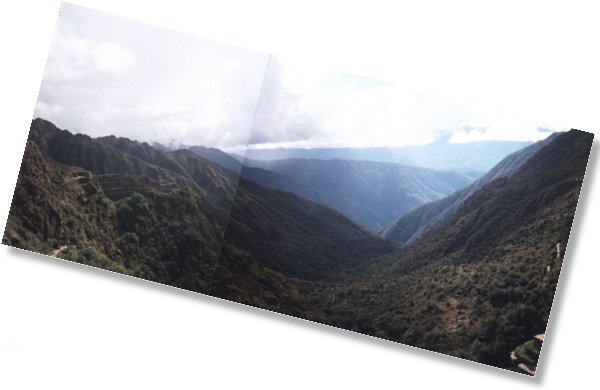 We went over the second pass, at almost exactly 4000 meters, and
walked a bit down to where our second night was spent, at
Sayacmarca. There's an Inca village ruin on a lookout there, with the
best view imaginable towards the high jungle, literally enshrouded in
an unknown history of events and a very well-known jungle mist. It met
all my expectations for Machu Picchu, so sitting up there at the
ruins, trying to see what this might have looked like when people
lived here, I had already achieved what I wanted on this trek.
We went over the second pass, at almost exactly 4000 meters, and
walked a bit down to where our second night was spent, at
Sayacmarca. There's an Inca village ruin on a lookout there, with the
best view imaginable towards the high jungle, literally enshrouded in
an unknown history of events and a very well-known jungle mist. It met
all my expectations for Machu Picchu, so sitting up there at the
ruins, trying to see what this might have looked like when people
lived here, I had already achieved what I wanted on this trek.
Back at the campsite the only accident on the trail happened, when one
of the Danish girls in the group, Anna, borrowed my roll of toilet
paper, and a few minutes later came back, blushing and embarrassed,
confessing that she had just dropped my paper into the toilet. There
was little point in appointing a search and rescue team to retrieve
it, that roll of toilet paper was now just as lost as the Inca
culture. And THAT is something to take seriously when you're a three
day walk away from the closest toilet paper outlet. An experienced
traveler of course always carries a backup supply of toilet paper.
A 30 minute, failed, Argentinian intense begging for a little Swedish
or Danish massage, followed by an all night croaking concert, led to
the third day on the trail. The weather called for rain ponchos, and
the walk was a very grey one up to the third and last pass at 3700
meters. I had a suspicion that the low visibility up there cheated me
out of some great views, but at the same time it was magical to walk
up there in the fog, listening to the sound of a pan flute from some
of the pervertedly fit porters who somewhere ahead was walking and
playing, almost like an Andean version of a marching band.
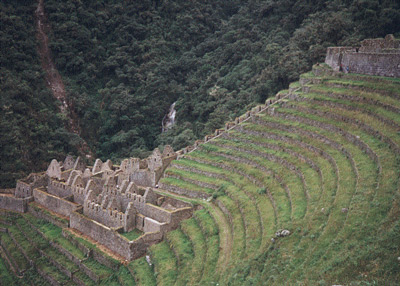
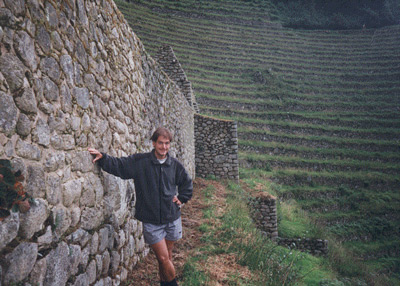
It took only 4 hours of walking to get to the last campsite, at
Winaywayna. The walk inside the poncho was quite the sweaty affair, so
I was delighted to discover that there was a hot shower available at a
guesthouse close to our tents. So with a clean body and a cold Coke I
was quite happy to be there, in spite of the 79 Swedish backpackers
that had come out of their 3 Pink Caravan buses to make noise on the
last part of the Inca Trail. They couldn't drown the thunderous
silence that covers the Inca ruins here, though, where we were free to
walk around until dinner just after sunset.
Dinner was some kind of vegetarian soup, and I had a hard time not
ordering some of the fast food that actually was available from the
guest house here. I couldn't bear the thought of not eating all the
stuff that our porters had carried all this way now. The Argentinian
playboys, who had suffered through more walking in three days now than
they had ever done before, were very happy men, though. Enrique and
Leandro, or Fred and Barney as I named them because they were both
mental and visual lookalikes of the The Flintstones characters,
exchanged their worried looks and heavy breathing with broad smiles in
their faces and sigarettes, beer and smiling broads in their hands,
dancing throughout the evening. At 9:30 the porters wanted to go to
bed, and tonight the bed would be the dancing floor and guesthouse
restaurant. So yet again we were sent to our tents, which was fine,
because outside the night was beautiful, with a close to full moon
lighting up the mist down in the valley to a clear, greyish white,
almost as bright as the snow on the mountaintops, and everything was
fine with stars on top.
It was just as well we were sent early to bed, because at 4 in the
morning we were woken up by the porters, who went from tent to tent
and served morning tea. The point of getting up this early was to be
able to start walking so that we would be at the Sun Gate, a lookout
point above Machu Picchu, at sunrise. It was a good plan, but it
almost failed, since some of the people in the group had become sick
enough during the night to make the guide look quite worried. The rest
of us had to wait until everything was sorted out, and by then it was
a quarter to six, and sunrise was less than an hour away. I ran with
my backpack on, and passed at least 50 Pink Caravaners, arriving at
the Sun Gate exactly as the sun must have risen, somewhere behind the
clouds. It was forgettable. I'm sure it must be a nice sight on sunny
mornings. Still, my first view of Machu Picchu was impressive
enough. It's a huge thing to get lost for so many centuries. Sure,
Angkor Wat was lost for a long time in a country run by maniacs, and
Finland is often forgotten by most people, but how such a magnificent
city on top of a mountain with excellent views in all directions can
be neglected for long enough to become covered in jungle is beyond my
comprehension. I'm real glad Hiram Bingham located and dug it out, and
even though there may be a bigger and more mysterious Inca city being
excavated and explored further north, at Maranpampa, there can hardly
be something more enchanting than a Machu Picchu drifting in and out
of the morning mist up the way you can see it here. And that's about
all I have to say about Machu Picchu, if you're really interested in
learning more about it, buy
a book.
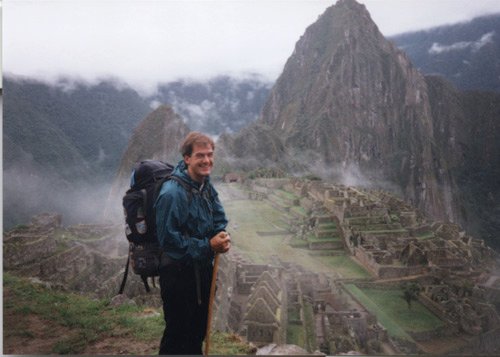
I walked around in Machu Picchu for quite a while, and I must confess
that although it was great, magical and all theat, I also thought it
was a pretty stupid place to put a city. The main explanation given
for it was that this is exactly where the sun will shine when it rises
on December 22, which is the summer solstice in the Southern
Hemisphere, but I have to say I would still chose a different place
for my city. They probably didn't have the souvenir shops and fast
food stalls standing around back then, either. Being smart enough to
build earthquake-proof buildings, they should be smart enough to also
realize that they would need quite a bit of water supply to keep them
happy, and way down below they could see the Rio Urubamba, with
infinite amounts of water. Oh well, at least they fooled the Spanish
soldiers, or maybe they didn't, maybe the Spaniards just forgot to
write down that they massacred a lot of Incas here and then left the
city as it was, since it didn't have golden streets anyway. We'll
never know.
When you're tired of the ruins, there's a lot of US$3 buses that will
take you down to Aguas Caliente, 8 kilometres in 25 minutes, on a road
with lots of hair-pin bends. OR you can do what I did, wanting to test
my knees one final time. I found this kid, dressed in Inca clothing,
who seemed to be working there as some kind of cultural attraction,
and told him I bet 5 soles (US$1.5), probably about a day's wage for
him, that I could run down to the river faster than he could. He took
me up on the offer, and ran down on the worst and steepest side trail
thinkable, going almost straight down to the river, several hundred
vertical meters below. I ran after him, with my backpack and poncho
and everything on, and it was a really good run. We passed the bus,
that had to zig-zag its way down, several times, with the passengers
cheering us on. Even if you come down first, you should give the kid
the money, it is amazing how money can mend a bit of hurt pride. I
did, and was happy this trek had ended, successfully.
The hot springs in Aguas Caliente are nowhere near as nice as the ones
in the Colca canyon, so until they rebuild the facilities that were
there before a major landslide in 1995, just don't go there. Instead
you should just sit down at one of the small, funny restaurants right
at the railway tracks, where you can order treats like "Bisteck to the
male" and "Egg to the Cuban", whatever that means. The train back to
Cuzco left at 16:30, and it was a slow one. The distance back to Cuzco
is more than 100 kilometres, and after dark fell it was not a very
exciting one. Not until we reached the outskirts of Cuzco, that is,
because there the shantytown children amused themselves by throwing
rocks at the train, so that the windows broke and glass was flying all
over the compartment. We tried to stay away from the windows like the
train officers told us, but that isn't so easy on a train. So the last
zig-zagging 30 minutes through Cuzco on our way to the train station
was definitely the most exciting part of the trip, unfortunately.
A cab brought me back to Tu Hogar, my definite choice for where to
stay whenever I'm in Cuzco. The room and my left luggage was just as
it had been when I left it four days earlier, so I just had an almost
warm shower, changed into clean clothes and went and had a large pizza
near the Plaza de Armas. Now, that was maybe not the right thing to
do. It triggered a fairly immediate shock reaction in my body. A kind
of "Whoa, it's been a few days since you actually used a toilet the
way you're used to"-reaction. So right after finishing the pizza I had
to walk back to Tu Hogar as quick as I could, cold-sweating and
whimpering all of the way, not exactly taking the time to admire the
Inca walls I now had learned so much about. Pardon me for getting into
details I know you never asked about, but when I made it back to my
room, I produced the biggest load I have ever seen, maybe except once
at an elephant breeding farm in Chitwan, Nepal. My body mass was
reduced with several percent in just one go. "Look at the size of that
thing!" was the only thing that came to my mind as I watched the
toilet struggle with swallowing its present workload. I don't know why
this happened, I really tried to go in the mountains, several times,
and while on the trek I just ate like I normally do. Maybe it had
something to do with consuming lots of coca leaves, coca tea and rice
while walking at high altitudes. Or maybe my subconsciousness says a
toilet is not a toilet unless it has water in it, and the rest of my
brain actually believes it.
Anyway, I went to bed that night feeling empty and utterly relieved.
By now all my clothes were dirty, smelly and wet from the walking in
rain and sweating. So I packed all my laundry in a bag and walked back
and forth in a street until one of the laundry pushers came up to me
and offered to end my suffering. It took about 30 seconds. I paid 2
soles per kilogram of laundry, with delivery the same evening. Then I
had my hair cut, for 4 nuevo soles, the cheapest haircut I had had for
several years. There were no mirrors to admire my new look in, but I
knew it looked perfect as soon as I walked out of there; all the rabid
dogs in Cuzco who previously came up to me all the time to have a
bite, now ran away as soon as they saw me. That was good value for
money. I was happy.
When I came to Cuzco the first time I had purchased a Boleto
Turistico, which is the only way for a tourist to get into the most
impressive churches and the cathedral, and the only way for the less
impressive churches to sell any tickets at all. All these places are
covered on a single, multi-day ticket that everybody have to buy
whether they want to see only one church or all of them. So, having
nothing better to do, I started my tour through the least interesting
churches of Cuzco, and it was kind of interesting. In the Catalina
nunnery, where the sermons were open for everyone, there were thick
grates between the area where the nuns were and where the rest of the
congregation would be, so that there would be no funny business
between the two groups. And in many of the churches the decorations
consisted mainly of mirrors, supposedly because this impressed the
indians a lot more than any amounts of gold and silver could do.
The volunteers from the UK were still hanging around without much
money, waiting for their flight, so my good deed for the day was to
take them to dinner at a place where they served real food. In return
they shared quite a lot of amusing stories about their projects and
their families, which came in handy seven months later when I traveled
in Britain and actually got to meet them.
I picked up my laundry in the evening, and discovered it had been
meticulously marked with some kind of colour coding. Apparently what
they do is to just throw lots of people's laundry into washing
machines and let it wash for a while, and then they sort out what
belonged to whom afterwards, and to help them with this, small threads
in different colours are sown onto each garment. It worked, I missed
nothing.
The next day was election day, so the streets had been filled with
police barriers and armored vehicles with water cannons on them. In
addition, all serving of alcohol was banned, so the atmosphere at
Dirty Nelly, the Irish pub in Cuzco (!), was pretty dead. I find it
all a bit scary, and was glad to be leaving early in the morning,
heading for the coast.
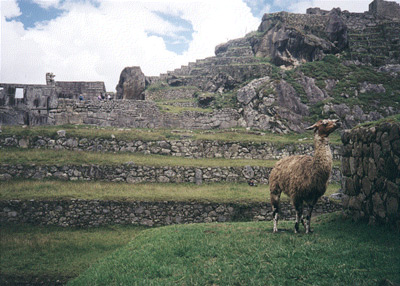
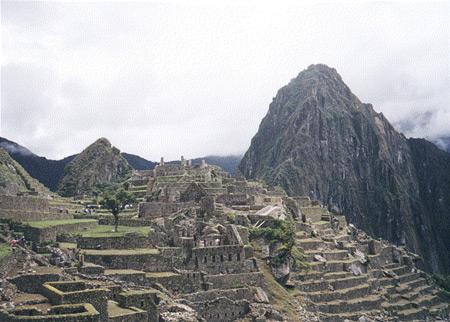
 I was seated between some Frenchmen and some Japanese, so I didn't
have to say anything for the whole duration of the trip, except for an
"Au revoir" and a "Sayonara" when we got off. That was okay with me, I
had brought a book and besides there was a 9 hour long postcard
outside the windows. First there was the amazingly blue Lake Titicaca
to enjoy, all still for the lack of wind on this spectacular
day. The train kept rolling, and was chased by rabid dogs past and
through lots of villages with beautiful churches surrounded by
shantytowns, where the train used to make stops in before the railway
company was privatized. In between there were farmland and mountains,
with lots of sheep and llamas looking at the train as if they've never
seen anything like it before. Sometimes there were shepherds following
the animals, and everywhere there were incredible terraces of maize and
potato fields climbing halfway up to the sky in the Cordillera
Blanca. It's enough to keep you occupied, like the toilet on the train
also was. Someone must have eaten something.
I was seated between some Frenchmen and some Japanese, so I didn't
have to say anything for the whole duration of the trip, except for an
"Au revoir" and a "Sayonara" when we got off. That was okay with me, I
had brought a book and besides there was a 9 hour long postcard
outside the windows. First there was the amazingly blue Lake Titicaca
to enjoy, all still for the lack of wind on this spectacular
day. The train kept rolling, and was chased by rabid dogs past and
through lots of villages with beautiful churches surrounded by
shantytowns, where the train used to make stops in before the railway
company was privatized. In between there were farmland and mountains,
with lots of sheep and llamas looking at the train as if they've never
seen anything like it before. Sometimes there were shepherds following
the animals, and everywhere there were incredible terraces of maize and
potato fields climbing halfway up to the sky in the Cordillera
Blanca. It's enough to keep you occupied, like the toilet on the train
also was. Someone must have eaten something.
 In central Cuzco the Spaniards incorporated the Inca buildings
into their own constructions, for instance "Q'orikancha", the Inca Sun
Temple, was used as the foundation for a large church. If you go a
bit outside the center, however, you can find original Inca stonework
still standing on its own. There is an old road, built by the Incas,
of course, leading from the city center up to Sacsayhuaman (easy to
remember, just think "sexy woman"), where I saw the most impressive
ruins I have seen anywhere. This is where the most massive stonework
can be found, forming something that looks a bit like a fortress with
a jagged outer wall. If you could have a look at the original Inca
Cuzco from above, the borders of the city would take the shape of a
large puma, and these walls form the teeth in the puma's mouth. It's
quite brilliant and must have been an almost inconceivable effort to
build in the first place, so long ago. The view from up there towards
the city is also excellent, it all looks like the Sim Medieval City
computer game will look if it's every made. The atmosphere up there
was a bit damaged by a very noisy rallycross race going on just behind
the ruins, but the stoneworks were enough to soon make me forget about
the cars.
In central Cuzco the Spaniards incorporated the Inca buildings
into their own constructions, for instance "Q'orikancha", the Inca Sun
Temple, was used as the foundation for a large church. If you go a
bit outside the center, however, you can find original Inca stonework
still standing on its own. There is an old road, built by the Incas,
of course, leading from the city center up to Sacsayhuaman (easy to
remember, just think "sexy woman"), where I saw the most impressive
ruins I have seen anywhere. This is where the most massive stonework
can be found, forming something that looks a bit like a fortress with
a jagged outer wall. If you could have a look at the original Inca
Cuzco from above, the borders of the city would take the shape of a
large puma, and these walls form the teeth in the puma's mouth. It's
quite brilliant and must have been an almost inconceivable effort to
build in the first place, so long ago. The view from up there towards
the city is also excellent, it all looks like the Sim Medieval City
computer game will look if it's every made. The atmosphere up there
was a bit damaged by a very noisy rallycross race going on just behind
the ruins, but the stoneworks were enough to soon make me forget about
the cars.





